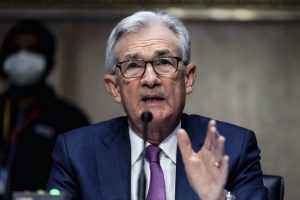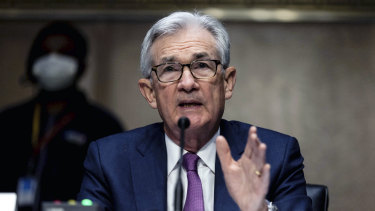Powell says Fed will lift rates if needed to contain ‘severe threat’ of inflation

Federal Reserve chair Jerome Powell pledged to do what’s necessary to contain an inflation surge and prolong the expansion, while steering clear of fresh details on the path of US monetary policy.
“If we have to raise interest rates more over time, we will,” Powell told a Senate Banking Committee on Tuesday under questioning at his confirmation hearing for a second term as central bank chief. “We will use our tools to get inflation back.”
Both Republicans and Democrats have expressed concern that the Fed is over-stimulating the economy with low rates and bond purchases as inflation runs far above officials’ 2 per cent target. US central bankers have been surprised by the persistence of inflation and want to lean against it this year without stalling out growth.
Jerome Powell says the Fed can handle any surge in inflation.Credit:AP
Prices rose 5.7 per cent for the 12 months ending November as measured by the personal consumption expenditures price index, the Fed’s preferred benchmark.
Powell’s remarks were more guarded than those of some of his colleagues, who’ve called openly for the Fed to starting raising rates at their meeting in March. But the chair typically tries to avoid providing policy guidance in public before he’s had a chance to discuss matters with the Fed’s policy-setting committee, which next gathers January 25-26.
While stressing that the Fed doesn’t prioritise its congressional mandate for price stability more than the goal for full employment, Powell said that the emphasis can shift and at the moment there was more focus on inflation.
“To get the kind of very strong labour market we want, with high participation, it is going to take a long expansion,” he said. “To get a long expansion we are going to need price stability. And so in a way, high inflation is a severe threat to the achievement of maximum employment.”
Meantime, Tuesday’s hearing underscored the bipartisan support Powell has for another term, starting next month. Senate Banking Committee Chair Sherrod Brown told Bloomberg he didn’t expect much change from the January 2018 vote that confirmed Powell for his first term. That count was 84-13.
President Joe Biden in November nominated Powell for a second term as chair and picked Fed Governor Lael Brainard to serve as vice chair. Brainard’s confirmation hearing is scheduled for Thursday. Biden is also expected to soon nominate three new governors to fill remaining vacancies on the board.
Financial markets took Powell’s remarks in their stride. Stocks erased losses, with the S&P 500 and the Nasdaq 100 pushing higher while bonds fluctuated.
“The ongoing vagueness about the timing of the first rate hike contrasts with the avalanche of comments from other Fed directors circling March 2022,” said Thomas Costerg, senior US economist at Pictet Wealth Management. “Bottom line: I have a sense Powell wants to calm things a bit and wants the market to digest quietly the last minutes – not add fuel to the fire.”
‘To get a long expansion we are going to need price stability. And so in a way, high inflation is a severe threat to the achievement of maximum employment.’
Investors are betting the Fed will begin raising its benchmark federal funds rate in March, two years after cutting it to nearly zero at the onset of the pandemic in March 2020. A Labor Department report on Friday showed the US unemployment rate fell to 3.9 per cent in December – closing in on the 3.5 per cent pre-pandemic low.
Fed officials in December said they would accelerate the end of their asset purchase program, and forecast they would raise rates three times this year. Wall Street firms such as Goldman Sachs Group are forecasting as many as four increases.
Powell, asked about plans to shrink the Fed’s $US8.77 trillion ($12 trillion) balance sheet, said at some point this year he and his colleagues will allow it to run off. His remarks follow comments from other Fed officials favouring a start to shrinking the balance sheet fairly soon after the central bank begins raising rates.
Noting that the US economy was in a much stronger position than the last time the central bank shrank its balance sheet – when it waited around two years between raising rates and allowing its holdings to run off, the chair said no decisions had been made but it would be quicker this time around.
“The balance sheet is much bigger and so the runoff can be faster. So I would say sooner and faster — that much is clear,” he said.
Bloomberg
Most Viewed in Business
From our partners
Source: Read Full Article

